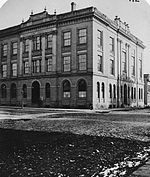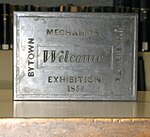Mechanics' institute
The mechanics' institutes often included libraries for the adult working class, and were said to provide them with an alternative pastime to gambling and drinking in pubs.It was as a result of delivering a lecture series at the Cheltenham Mechanics' Institute that the radical George Holyoake was arrested and then convicted on a charge of blasphemy.[3] Beyond a lending library, mechanics' institutes also provided lecture courses, laboratories, and in some cases contained a museum for the members' entertainment and education.[14] G. Jefferson explains: The first phase, the Mechanics Institute movement, grew in an atmosphere of interest by a greater proportion of the population in scientific matters revealed in the public lectures of famous scientists such as Faraday.More precisely, as a consequence of the introduction of machinery a class workmen emerged to build, maintain and repair, the machines on which the blessing of progress depended, at a time when population shifts and the dissolving influences of industrialization in the new urban areas, where these were concentrated, destroyed the inadequate old apprentice system and threw into relief the connection between material advancement and the necessity of education to take part in its advantages.[16] As of 2021, there have been five such conferences:[17] Thousands of mechanics' institutes buildings still operate throughout the world, mostly now used as libraries, parts of universities, adult education facilities, and a few still use their original names and function as a society or other type of organisation.The provision of reading rooms, museums, lectures and classes were still important, but the Australian schools were also more likely to include a social programme in their calendar of events.[30] In the following decades, almost every town in Victoria had a mechanics' institute, usually including a hall, library and reading rooms, games facilities, and both educational programs and entertainment.








School of Arts (disambiguation)Leeds City Mechanics' InstituteAustralian coloniesadult educationVictorian-eraits colonieslibrariesworking classlending librariesVictoria, AustraliaGeorge BirkbeckAndersonian InstituteLondonEdinburghEdinburgh School of ArtsHeriot-Watt UniversitychemistryLiverpoolGlasgownatural philosophyWakefield Mechanics' InstituteLondon Mechanics' InstituteBirkbeck CollegeIpswichManchesterUniversity of GloucestershireGeorge HolyoakeHobartSydney Mechanics' School of ArtsNewcastleMelbourneMelbourne AthenaeumVictoriaIndustrial RevolutionBirminghamPublic Libraries Act 1850lending librarygas light companyWisbechMrs ButlerShakespeareMiltonParadise Lostsubscription librariesSwinburne UniversityPrahran, VictoriaBath Royal Literary and Scientific InstitutionBath, SomersetRMIT UniversityMechanics' InstituteSan FranciscoCaliforniaCOVID-19 pandemicMechanics' Institutes of AustraliaTasmaniaGeorge Augustus RobinsonSydneyNew South WalesMoruya Mechanics' InstituteScone School of ArtsSouth AustraliaState Library of South AustraliaSouth Australian MuseumArt Gallery of South Australiacolony of VictoriaMelbourne Mechanics' InstituteMoonambelWestern AustralianSwan River Mechanics' InstituteQueenslandBrisbane School of ArtsQueensland Heritage RegisterBytown Mechanics' InstituteHalifax Mechanics InstituteSt. John Mechanics' InstituteBarrie Mechanics' InstituteOttawa Public LibraryHamilton and Gore Mechanics' InstituteKingston Mechanics' InstituteMechanics' Institute (Orillia)Owen Sound Mechanics InstitutePeterborough Mechanics' InstituteToronto Mechanics' InstituteAtwater Library of the Mechanics' Institute of MontrealMontreal Children's LibraryGovernment trade schoolAuckland City Council libraryAberdeenArchibald SimpsonAlford InstituteBostonBradford Mechanics' Institute LibraryBurnley MechanicsBurnleyDarlington Mechanics InstituteGainsborough Old HallGrimsby, LincolnshireKeighleyKeighley CollegeLeeds Mechanics' InstituteCuthbert BrodrickLeeds City MuseumLincoln Mechanics' InstituteGreyfriarsLiverpool Institute High School for BoysLiverpool Institute for Performing ArtsBirkbeck, University of LondonLurganCounty ArmaghUniversity of Manchester Institute of Science and TechnologyVictoria University of ManchesterUniversity of ManchesterMarsdenUniversity of South WalesOtley Mechanics InstituteSpitalfieldsThomas Field GibsonStamford, LincolnshireSwindon Mechanics' InstituteNew Haven, ConnecticutThe Young Men's Institute LibraryMassachusetts Charitable Mechanic AssociationBoston, MassachusettsGeneral Society of Mechanics and Tradesmen of the City of New YorkEnglish High SchoolFranklin Institute
